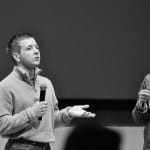Bloomington hosts weekend of family bicycle events, answers question: Where does the car go?





On Saturday morning, the garage door to Bloomington’s Bike Project was open to a bright, crisp fall morning—a couple hours earlier than the posted hours, which start at noon. It’s a spot where loads of people walk past on any given Saturday, on their way to the Farmers Market, just north of there.
The open house for the bicycle cooperative was synched up with Cargo Bike Show & Tell, one of the events scheduled for Bloomington’s first annual Fall Family Bike Fest—which started Thursday and ran through Sunday.
The upcoming start of the Bike Fest was heralded on Tuesday afternoon, with the hanging of a new billboard on the northeast corner of 6th and Walnut streets, where the Subway recently closed up shop. The bicycle-themed billboard was designed by Pealer Bryniarski for the Your Art Here space. Funding for the billboard came from a Local Motion grant award, made by Bloomington’s bicycle and pedestrian safety commission to The Bike Project.
The digital collage Bryniarski designed features several hands adding bits to a super-long bicycle under construction, reflecting the spirit of inclusion that the Bike Project tries to foster. Bryniarski told The Beacon he’s learning to weld, so that he can build a cargo bike.
By 11 o’clock on Saturday, a handful of two-wheeled, pedal powered machines designed to haul loads, not just people, were lined up on a blocked-off 7th Street, where the B-Line Trail crosses the road, within easy shouting distance of the Bike Project.
One of the cargo bikes belonged to Mark Stosberg, who serves on Bloomington’s bicycle and pedestrian safety commission. Asked if he has anything against bicycle trailers for hauling heavy loads, he said the choice is similar to the choice between a pickup truck and a car with a trailer.
A cargo bike is more maneuverable and has fewer wheels than a bicycle-plus-trailer rig, and that means fewer tires to go flat. And every tire adds rolling resistance, Stosberg said. That said, he also owns a cargo trailer—Stosberg showed The Beacon a photo on his smartphone of his Bikes At Work trailer weighed down with a load after a visit to Lowe’s.
Later on Saturday, Stosberg gave a few remarks before the free screening of “Motherload” at the Buskirk-Chumley Theater. The film is a documentary on cargo bikes by Liz Canning, which includes her personal story about her choice to use a cargo bike to haul her twins around. The film, which in part used crowd-sourced footage, includes a look at the role of the bicycle in the liberation of women dating back more than a hundred years.
Among the contributors of footage to “Motherload” was Stosberg. In his remarks before the screening, he echoed one of the threads that ran through the collage of vignettes in the film—the idea of establishing the use of a bicycle to get around and to haul things as normal. There’s only a short time to define for children what “normal” is, Stosberg said.
Emcee for the Buskirk-Chumley screening was Mallory Rickbeil, Bloomington’s bicycle and pedestrian coordinator. Rickbeil announced the award of this year’s Local Motion grant. The grant program supports “initiatives that focus on cultural, day to day, or other locally-based activities that also aim to strengthen our diverse and vibrant bicycling and walking culture.”
The $1,500 award went to The Bike Project, which operates as part of Bloomington’s Center for Sustainable Living. The Bike Project was chosen, Rickbeil said, because of its three-tiered approach: the 6th and Walnut billboard, a bike light/reflector giveaway, and a wheel storage facility.
At the Bike Project on Saturday morning, Makenzie Hoagland gave The Beacon a quick tour of the facility, including the back, where dozens of wheels are jammed into some cubicles on the wall. Hoagland supervises shifts and coordinates events for the non-profit. The idea for the wheel storage unit is to design an efficient system so that a specific wheel can be retrieved from the collection, without rooting through a pile, she said.
Hoagland also described the core program of The Bike Project, which is Earn-a-Bike—volunteer for three hours and you can build your own bike from a frame and parts in the shop. The place is packed with bicycles, some for sale.
Several bicycles probably had stories to tell. A muscle bike with a banana seat was among them. Hoagland pointed to one with a red bow tied to its handlebars—part of that bike’s story had to be that be that it was a gift, she said.
Hoagland will be including part of her own story in an ethnography she’s writing about the place. She’s an anthropologist by training. What she’s writing up will capture a phase of her involvement with The Bike Project when she was still on the edge of the project’s community, not yet fully incorporated, she said.
“The Bike Project is a community shop,” she said, “you become a part of it, if you come here a lot.”
Click to view slideshow.




Comments ()